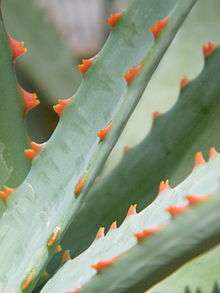Aloe perryi
| Socotrine aloe | |
|---|---|
 | |
| Scientific classification | |
| Kingdom: | Plantae |
| Clade: | Angiosperms |
| Clade: | Monocots |
| Order: | Asparagales |
| Family: | Asphodelaceae |
| Subfamily: | Asphodeloideae |
| Genus: | Aloe |
| Species: | A. perryi |
| Binomial name | |
| Aloe perryi Baker | |
| Synonyms | |
|
Aloe forbesii Balf.f. ; Aloe socotrina | |
Aloe perryi (syn. Aloe forbesii Balf.f.; Aloe socotrina) is a species of plant in the genus Aloe. It is endemic to Socotra in Yemen, and is often known by its common name, Socotrine aloe.[1] Its natural habitat is rocky areas. Widely distributed and in places abundant. Bitter aloes – the juice of Aloe perryi – has important pharmaceutical and medicinal properties. At present, it is under no immediate threat but some populations are potentially vulnerable to pests, climate change and over-harvesting.
Description
Perennials; stems 1.5 M. (5°) high, woody, rough from leaf-remnants; leaves glaucous-green, often with darker spots, thick, succulent, bayonet-shaped, margin with reddish spines or serratures; flowers racemose or spicate, tubular, yellowish, orange-red; stamens 6, unequal, 3 longer than corolla. Inspissated juice (aloes - A. Perryi): Socotrine, blackish-brown, opaque, or smooth glistening masses, fracture conchoidal, sometimes soft; odor aromatic, saffron-like, never fetid, putrid; taste nauseous, bitter; 50 p. c. soluble in cold water.[2]
References
- Miller, A. 2004. Aloe perryi. 2006 IUCN Red List of Threatened Species. Downloaded 20 August 2007.
